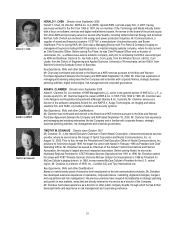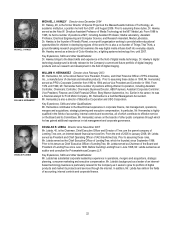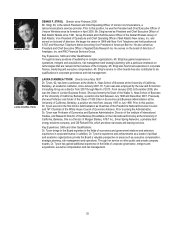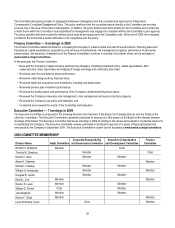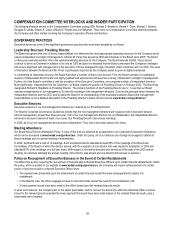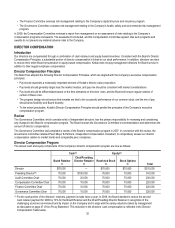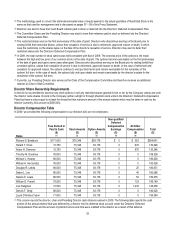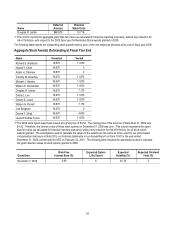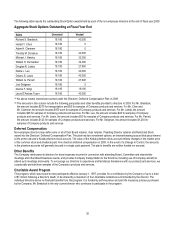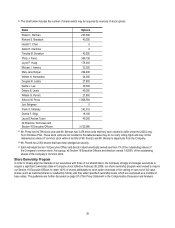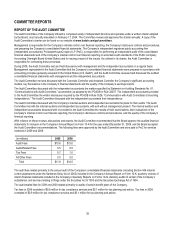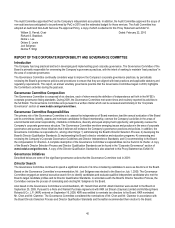Kodak 2009 Annual Report Download - page 175
Download and view the complete annual report
Please find page 175 of the 2009 Kodak annual report below. You can navigate through the pages in the report by either clicking on the pages listed below, or by using the keyword search tool below to find specific information within the annual report.31
recommendations. Once the goals are established by the Board, the Governance Committee is responsible for tracking the Board’s
performance against its goals and routinely reporting these results to the Board. Performance against the goals is assessed as part of the
Board’s annual evaluation process.
Strategic Role of Board
The Board plays a key role in developing, reviewing and overseeing the Company’s business strategy. Each year, the Board devotes an
extended meeting to an update from management regarding the strategic issues and opportunities facing the Company and its businesses.
In addition, the Board throughout the year reviews the Company’s strategic plan and receives briefings and reports on critical aspects of its
implementation. These include business unit performance and strategy reviews, product category reviews and presentations regarding
research and development initiatives and the Company’s intellectual property portfolio.
Succession Planning
The entire Board reviews the Company’s succession plans for its CEO and other key senior management positions and oversees the
Company’s activities in the areas of leadership and executive development. To assist the Board, management provides regular updates on
succession planning to ensure that it is a continuous and ongoing effort.
Majority Voting for Directors
In February 2009, the Board amended the Company’s By-laws, as a result of a change in New Jersey law, providing for majority voting in
uncontested director elections. Previously, the Company had a policy providing for the election of directors by majority vote in uncontested
elections. The change in New Jersey law allowed the Company to implement majority voting of directors in uncontested elections via a by-
law amendment.
Along with the by-law amendment, the Board also amended the Company’s Majority Vote Policy to address the so-called “holdover” rule of
New Jersey law. Under this rule, a director who fails to receive the required votes for reelection remains in office until his or her resignation
or removal.
The amended Majority Vote Policy requires a director nominee, in connection with his or her nomination to the Board, to submit a
resignation letter in which the director nominee irrevocably elects to resign if he or she fails to receive the required majority vote in the next
election and the Board accepts the resignation. The policy requires the Board to nominate for election or reelection as director only those
candidates who agree to execute such a letter upon his or her nomination. A copy of the amended Majority Vote Policy can be found on
the Company’s corporate governance website at www.kodak.com/go/directors.
If a director nominee fails to receive a majority vote in an uncontested election, the amended Majority Vote Policy provides that the
Governance Committee will consider the resignation letter and recommend to the Board whether to accept it. The Governance Committee,
in making its recommendation to the Board, and the Board, in reaching its decision, may under the policy consider relevant factors,
including any stated reason why shareholders voted against the election of the director, the director’s qualifications, the director’s past and
expected future contributions to the Company, the overall composition of the Board and whether accepting the resignation letter would
cause the Company to fail to meet any applicable rule, such as the NYSE’s Listing Standards.
The policy provides that the Board will act on the Governance Committee’s recommendation and publicly disclose its decision whether to
accept the director’s letter of resignation within 90 days following the certification of the shareholder vote. If the letter of resignation is not
accepted by the Board within this 90-day period, the resignation will not be effective until the next annual meeting.
All of the director nominees standing for election at the Annual Meeting have submitted an irrevocable letter of resignation as a condition of
being renominated to the Board as called for under the amended Majority Vote Policy.
Risk Management
Our Board oversees an enterprise-wide approach to risk management, designed to support the achievement of the Company's objectives,
including strategic objectives, to improve long-term performance and enhance shareholder value. A fundamental part of risk management
is not only understanding the risks the Company faces and what steps management is taking to manage those risks, but also
understanding what level of risk is appropriate for the Company. The involvement of the full Board in setting the Company's business
strategy necessarily entails a determination of what constitutes an appropriate level of risk for the Company. The full Board also
participates in an annual enterprise risk assessment which is led by the Company's Chief Compliance Officer. In this process, risk is
assessed throughout the Company, focusing on four primary categories of risk: strategic, operational, legal/compliance and financial
reporting. In 2009, the Board received a report on the results of the Company's enterprise risk assessment.
While the Board has assumed oversight responsibility for the Company's risk management process, the Board has delegated to its
Committees responsibility for the oversight of the Company’s risk management in specific risk areas. For example:
• The Audit Committee oversees the Company’s financial reporting (including internal controls) and compliance risk management.
• The Executive Compensation and Development Committee oversees risk management relating to the Company's executive
compensation programs and awards.


